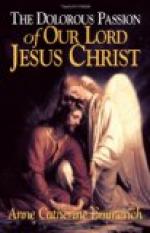Her journeys to the Holy Land were made, according to the accounts she gave of them, by the most opposite roads; sometimes even she went all round the earth, when the task spiritually imposed upon her required it. In the course of these journeys from her home to the most distant countries, she carried assistance to many persons, exercising in their regard works of mercy, both corporal and spiritual, and this was done frequently in parables. At the end of a year she would go over the same ground again, see the same persons, and give an account of their spiritual progress or of their relapse into sin. Every part of this labour always bore some reference to the Church, and to the kingdom of God upon earth.
The end of these daily pilgrimages which she made in spirit was invariably the Promised Land, every part of which she examined in detail, and which she saw sometimes in its present state, and sometimes as it was at different periods of sacred history; for her distinguishing characteristic and special privilege was an intuitive knowledge of the history of the Old and New Testaments, and of that of the members of the Holy Family, and of all the saints whom she was contemplating in spirit. She saw the signification of all the festival days of the ecclesiastical year under both a devotional and a historical point of view. She saw and described, day by day, with the minutest detail, and by name, places, persons, festivals, customs, and miracles, all that happened during the public life of Jesus until the Ascension, and the history of the Apostles for several weeks after the Descent of the Holy Ghost. She regarded al her visions not as mere spiritual enjoyments, but as being, so to speak, fertile fields, plentifully strewn with the merits of Christ, and which had not as yet been cultivated; she was often engaged in spirit in praying that the fruit of such and such sufferings of our Lord might be given to the Church, and she would beseech God to apply to his Church the merits of our Saviour which were its inheritance, and of which she would, as it were, take possession, in its name, with the most touching simplicity and ingenuousness.
She never considered her visions to have any reference to her exterior Christian life, nor did she regard them as being of any historical value. Exteriorly she knew and believed nothing but the catechism, the common history of the Bible, the gospels for Sundays and festivals, and the Christian almanac, which to her far-sighted vision was an inexhaustible mine of hidden riches, since it gave her in a few pages a guiding thread which led her through all time, and by means of which she passed from mystery to mystery, and solemnised each with all the saints, in order to reap the fruits of eternity in time, and to preserve and distribute them in her pilgrimage around the ecclesiastical year, that so the will of God might be accomplished on earth as it is in Heaven. She had never read the Old or the New Testaments, and when she was tired of relating her visions, she would sometimes say: ‘Read that in the Bible,’ and then be astonished to learn that it was not there; ‘for,’ she would add, ’people are constantly saying in these days that you need read nothing but the Bible, which contains everything, etc., etc.’




